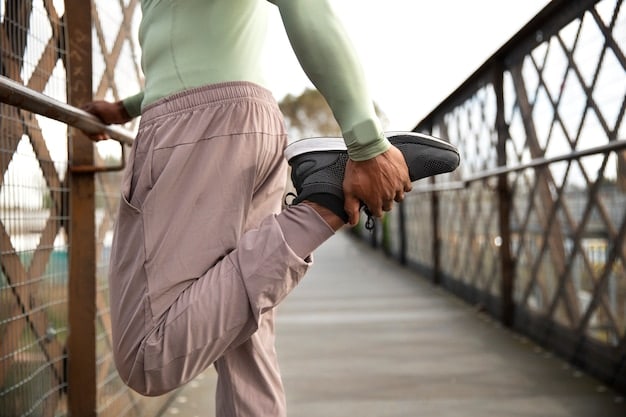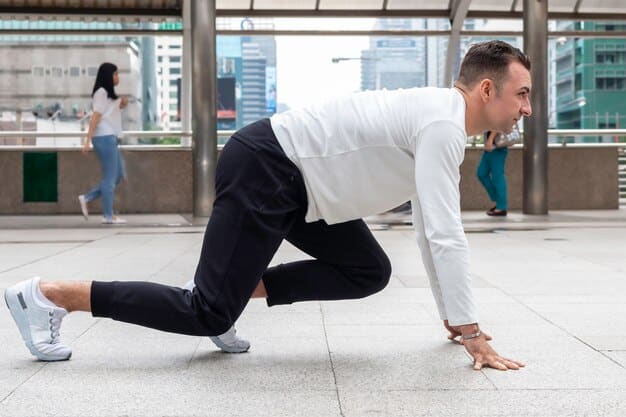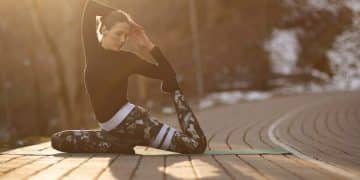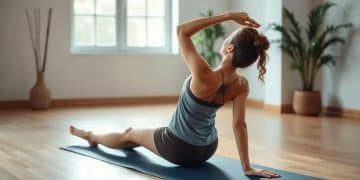Yoga for Runners: 4 Poses to Boost Performance & Prevent Injury

Yoga for runners offers a powerful combination to enhance performance and prevent injuries by improving flexibility, strength, and mental focus, particularly through these four key poses.
Many runners overlook the benefits of stretching and flexibility, often leading to injuries and plateaus in performance. Yoga for runners: Improve performance and prevent injuries with these 4 poses, integrates the practice to provide a complementary approach, addressing these common issues by enhancing flexibility, building strength in key muscle groups, and improving mental focus to create a more balanced and injury-resilient athlete.
Why Yoga is a Game Changer for Runners
Running is a demanding sport, placing repetitive stress on specific muscle groups, which can lead to imbalances and injuries. Yoga, on the other hand, offers a holistic approach, addressing flexibility, strength, and mental well-being. By incorporating yoga into your routine, you can counteract the negative effects of running and experience significant improvements in your overall performance.
Improved Flexibility and Range of Motion
Running often tightens muscles like hamstrings, hip flexors, and calves, restricting range of motion. Yoga poses help lengthen these muscles, increasing flexibility and allowing for a more efficient stride.
Enhanced Strength and Stability
Yoga builds strength, especially in the core and lower body, which are crucial for maintaining good running form and preventing injuries. Poses like plank and warrior series engage these muscles, promoting stability and power.

Including these benefits in your regimen can lead to significant improvements in running efficiency in the long-term.
- Increased Efficiency: Greater flexibility and strength lead to a more efficient stride, reducing energy expenditure.
- Injury Prevention: Balanced muscle development and increased flexibility minimize the risk of common running injuries.
- Improved Recovery: Yoga promotes blood flow and reduces muscle soreness, speeding up the recovery process.
In conclusion, yoga offers a comprehensive set of advantages for runners, addressing key areas of weakness and imbalance to improve performance and resilience.
Pose 1: Downward-Facing Dog (Adho Mukha Svanasana)
Downward-facing dog is a foundational yoga pose that is particularly beneficial for runners. It stretches the hamstrings, calves, and spine, while also strengthening the arms and shoulders. This pose helps alleviate tension in the lower body and improves overall flexibility.
Downward-facing dog (Adho Mukha Svanasana) provides a full-body stretch and strengthens supporting muscles.
How to Perform Downward-Facing Dog
Start on your hands and knees, with your hands shoulder-width apart and your knees hip-width apart. Tuck your toes and lift your hips up and back, forming an inverted V-shape. Press evenly through your hands and feet, and lengthen your spine. Hold for 5-10 breaths, focusing on deepening the stretch in your hamstrings and calves.
Benefits for Runners
This pose provides several benefits for runners, including increased flexibility in the hamstrings and calves, improved spinal mobility, and strengthened upper body.
- Hamstring and Calf Stretch: Relieves tightness and improves flexibility, essential for efficient running.
- Spinal Mobility: Lengthens and decompresses the spine, reducing back pain and improving posture.
- Upper Body Strength: Strengthens arms and shoulders, improving overall stability and form.
Downward-facing dog is a versatile pose that can be easily incorporated into your warm-up or cool-down routine, providing a multitude of benefits for runners.
Pose 2: Low Lunge (Anjaneyasana)
Low lunge is an excellent pose for opening up the hip flexors, which are often tight in runners due to the repetitive nature of the sport. This pose also strengthens the legs and improves balance, contributing to better running form and injury prevention.
Low lunge (Anjaneyasana) targets the hip flexors, strengthens the legs, and improves balance for runners.
How to Perform Low Lunge
Start in downward-facing dog. Step your right foot forward between your hands, aligning your knee directly over your ankle. Lower your left knee to the ground, and untuck your toes. Inhale and lift your torso, reaching your arms overhead. Hold for 5-10 breaths, then repeat on the other side.
Benefits for Runners
It addresses key areas of tightness and weakness, promoting improved flexibility, strength, and balance.
Practicing low lunges has the potential to enhance your running performance.
- Hip Flexor Stretch: Releases tension in the hip flexors, improving range of motion and stride length.
- Leg Strengthening: Strengthens the quadriceps, hamstrings, and glutes, enhancing lower body power and stability.
- Balance Improvement: Challenges balance, improving proprioception and reducing the risk of falls and injuries.

Low lunge is a valuable addition to any runner’s yoga practice, counteracting the common tightness in the hip flexors and promoting overall lower body strength and balance.
Pose 3: Pigeon Pose (Eka Pada Rajakapotasana)
Pigeon pose is a deep hip opener that targets the glutes and piriformis muscles. These muscles can become tight with running, contributing to hip and knee pain. Pigeon pose helps release this tension, promoting greater flexibility and reducing the risk of injury.
Pigeon pose (Eka Pada Rajakapotasana) to alleviate hip and knee pain, leading to more comfortable and efficient runs.
How to Perform Pigeon Pose
Start in downward-facing dog. Bring your right knee forward towards your right wrist, placing your right ankle towards your left wrist. Angle your right shin as parallel to the front of your mat as is comfortable. Slide your left leg back, straightening your knee and pointing your toes. Square your hips towards the front of your mat. Inhale and lengthen your spine, then exhale and fold forward over your right leg. Hold for 5-10 breaths, then repeat on the other side.
Benefits for Runners
Pigeon also provides relief from tightness in the hips and improved flexibility.
Consistent practice of pigeon pose can lead to significant improvements in hip mobility and overall comfort while running.
- Glute and Piriformis Release: Alleviates tightness in the glutes and piriformis muscles, reducing hip and knee pain.
- Hip Opening: Increases flexibility and range of motion in the hips, promoting better alignment and movement patterns.
- Stress Reduction: Promotes relaxation and reduces stress, which can contribute to muscle tension and pain.
Pigeon pose is a powerful tool for runners to release tension in the hips and improve overall lower body flexibility, reducing the risk of injury and enhancing performance.
Pose 4: Bridge Pose (Setu Bandhasana)
Bridge pose strengthens the glutes, hamstrings, and core, which are essential for maintaining good running form and preventing injuries. This pose also opens the chest and shoulders, counteracting the hunched posture that can develop from running. This all contributes to more efficient running.
Bridge pose (Setu Bandhasana) to enhance running efficiency and prevent injuries.
How to Perform Bridge Pose
Lie on your back with your knees bent and your feet flat on the floor, hip-width apart. Place your arms alongside your body, with your palms facing down. Inhale and press your feet into the floor, lifting your hips up towards the ceiling. Engage your glutes and hamstrings, and keep your knees aligned over your ankles. Hold for 5-10 breaths, then slowly lower your hips back down to the floor.
Benefits for Runners
By targetting key muscle groups, this pose helps enhance stability, strength, and overall running performance.
- Glute and Hamstring Strengthening: Strengthens the glutes and hamstrings, improving power and stability.
- Core Engagement: Activates the core muscles, enhancing spinal stability and balance.
- Chest and Shoulder Opening: Counteracts hunched posture, improving breathing capacity and overall alignment.
Bridge pose is a valuable pose for runners, strengthening key muscle groups, opening the chest and shoulders, and improving overall body alignment.
Creating a Yoga Routine for Runners
To maximize the benefits of yoga, runners should incorporate it into their routine consistently. A well-structured yoga routine can complement your running schedule, enhancing performance and preventing injuries.
To achieve this, it is important to factor in your running and yoga routine.
Frequency and Timing
Aim to practice yoga 2-3 times per week, either on your rest days or after shorter runs. Avoid doing intense yoga sessions immediately before or after long runs, as this can increase the risk of injury.
Warm-up and Cool-down
Include yoga poses in your warm-up to increase flexibility and prepare your muscles for running. Use yoga as a cool-down to reduce muscle soreness and promote recovery.
Listen to Your Body
Pay attention to your body and avoid pushing yourself too hard, especially when you are new to yoga. Modify poses as needed and rest when you feel tired or sore.
By following these guidelines, runners can create a yoga routine to complement their training, improving performance, preventing injuries, and enhancing overall well-being.
| Key Point | Brief Description |
|---|---|
| 💪 Strength | Yoga builds core and lower body strength, crucial for running form. |
| 🤸 Flexibility | Poses like Downward Dog enhance flexibility in tight areas like hamstrings. |
| 🧘 Balance | Yoga improves balance and proprioception, reducing injury risk. | 🤕 Injury Prevention | By addressing flexibility and strength, yoga can prevent common running injuries. |
Frequently Asked Questions
What is the best time to do yoga after running?
Doing yoga post-run helps muscles recover by promoting blood flow and reducing soreness. Allow a short cooldown period, around 15-20 minutes, to prevent overexertion when transitioning into yoga.
How often should runners practice yoga?
For optimal results, runners should aim to incorporate yoga into their routine 2-3 times per week. Consistency is key; regular sessions yield better flexibility, strength, and injury prevention.
Can yoga replace stretching for runners?
What specific types of yoga are best for runners?
Styles like Hatha and Restorative yoga focus on fundamental poses and relaxation, fostering flexibility and stress relief, which is beneficial to runners. These are useful for recovery.
Are there any yoga poses runners should avoid?
Runners should steer clear of poses that cause sharp pain or strain, especially if they have knee or hip issues. Poses requiring extreme flexibility may also be challenging and should be approached with caution.
Conclusion
In conclusion, incorporating these four yoga poses into your running routine can significantly enhance your performance and reduce the risk of injuries. Downward-facing dog, low lunge, pigeon pose, and bridge pose each offer unique benefits, addressing key areas of flexibility, strength, and balance that are essential for runners.





